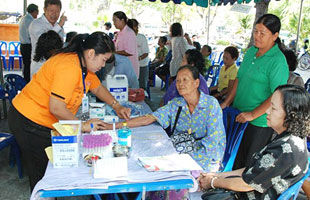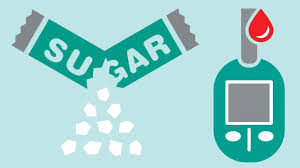Thailand Medical News Feb 14, 2019 6 years, 9 months, 2 weeks, 13 hours, 17 minutes ago
As in much of the rest of the developed and middle-income nations, diabetes is creating a public health crisis in Thailand. Doctors face a complicated set of challenges related to the illness – not only in how to treat those already affected, but how to prevent the debilitating disease moving into the future. Measures such as proper dietary education and the promotion of exercise, especially for children, can potentially mitigate the prevalence of diabetes for subsequent generations.
Health advocacy groups and researchers have long warned of the creeping diabetes dilemma, advising in one
published paper that “The prevalence of type 2 diabetes has been increasing exponentially, and a high prevalence rate has been observed in developing countries and in populations undergoing ‘westernization’ or ‘modernization.”
For many, “westernization” and “modernization” are overwhelmingly positive, signifying an
improvement in health outcomes as well as generalized progress in all areas of life. While it is true that modernity has fostered treatment and prevention of an array of illnesses -- in some cases, like polio, eradicating them from the planet – recent trends have caused unforeseen consequences for health as well, such as diabetes and other “modern” diseases.
The Origins of Diabetes in Thailand and Elsewhere
Previously, diabetes had been a quite rare condition. Following the industrial revolution, however, lifestyles and diets changed rapidly – and disease patterns along with them.
In the bygone era of the extraction of conventional “sugar cane” which lasted throughout Southeast Asian and the rest of the world until the mid-20
th century, sweetening meals with this substance as a food additive was labor-intensive and quite challenging, limiting the mass-production of sugar and thus worldwide consumption.
What sugar was consumed, therefore, was generally sourced from naturally-occurring whole foods like fruits. In Thailand, bananas and coconuts have long been such sources of sugar. Although fruits like these are indeed significant sources of dietary sugar, they also contain important amounts of fiber which can considerably slow the rate of sugar absorption by the gut, leading to lower levels of the diabetes-triggering insulin response – over time, reducing the risk of developing the disease. The National Institutes of Health reported in a 2010 study:
“The digestive and viscosity characteristics of dietary fiber are the likely modes of action which affect diabetes and obesity risk. These mechanisms appear to decrease nutrient absorption, therefore, decreasing metabolizable energy. Dietary fiber may also be able to decrease gross energy of a food due to its lower energy density.”
A Russian chemist named Gottlieb Kirchhoff discovered, secondary to other pursuits, that the introduction of hydrochloric acid to corn starch created a sugar substance called
“corn syrup”. This breakthrough went largely unnoticed at the time. Although nothing changed significantly in the agricultural sector then, the stage had been set for a monumental shift in consumption habits over a century later.
In the 1950s, the American corporation Clinton Corn Processing Company built on Kirchhoff’s corn syrup with the advent of industrial-scale high fructose corn syrup (HFCS). By adding a number of enzymes to conventional corn syrup, 42-90% of the glucose was converted into fructose. The result was an easily mass-produced substitute for sugar. Corporations soon took advantage of this newly available form of sweetener, and the “sugar revolution” began in earnest.
The “Sugar Revolution” Aftermath
In 2019, in Thailand and elsewhere, all manner of commercially produced processed foods, including the majority of what is available in convenience stores, contain excessive amounts of HFCS: candy, soda, juices, gums, condiments, coffee creamers, and so-called energy drinks.
HFCS has even made its way into foods that had been produced for millennia without added sugar: bread, milk, yogurt, ice cream, and fruit juices.
These food options, which are rapidly becoming staples of the Thai diet, lack any of the dietary fiber that could act as a barrier to delay absorption of the sugar and the resulting insulin spikes. As this
study confirms, the health results of these products can be extremely problematic:
“Epidemiologic evidence favors the hypothesis that obesity may result from the fiber-depleted diet of industrialized societies… dietary factors causing excess insulin secretion might lead to obesity… high fiber starchy foods cause a much lesser insulin response than does glucose in solution.”
In short, the car (sugar) is speeding along with no brakes (fiber) to slow it down, dangerously spiking insulin again and again and again, increasing the sensitivity to the hormone, and ultimately resulting in type-2 diabetes for a growing number of adults and children in Thailand. Doctors, unfortunately, often can only intervene once the patient has already traveled extensively down the disease pathway.
Sugar Intake among Thais
As this review of aggregated studies published by PubMed notes, exact data analyzing sugar consumption habits in Thailand is difficult to ascertain due to incomplete research design and difficult in control of confounding factors:
“Insufficient evidence exists regarding intake levels and sources of added sugar in Thailand. Limitations were the use of food frequency questionnaires or a single 24-h recall to assess intake, and outdated studies with small sample sizes. An updated nationally representative survey using improved methods is needed.”
However, there remains little doubt of the massive increase in consumption of sugar in Thailand. Apart from casual observation, some of the many reports which attempt to determine exact intake offer dire conclusions; in 2010, the National Statistical Office (NSO) of Thailand reported an “available supply of 83 g sugar per capita per day” in the Kingdom.
Public Health Interventions
Attempts to control sugar intake among the general population have previously proven controversial. For example, in this analysis of a 2006 New York City program to curb its use, the National Institutes of Health
reported that “policy proposals included an excise tax, a restriction on use of Supplemental Nutrition Assistance Program benefits, and a cap on sugary drink portion sizes in food service establishments.” The attempt to limit sizes of HFCS-laden drinks ultimately failed in court, and the restriction has since been lifted. Public education campaigns remain the only feasible means to reduce sugar intake.
Another National Institutes of Health study in 2018 called for further investigation into strategies to combat sugar consumption:
“Research to address current limitations in the evidence on interventions to reduce intake of sugars can help build a stronger and more cohesive body of literature with which to inform policies and programs.”
Perhaps one population to research with might be found in Thailand; doctors facing the rising obesity epidemic in the Kingdom can surely use all the evidence-based approaches available.

